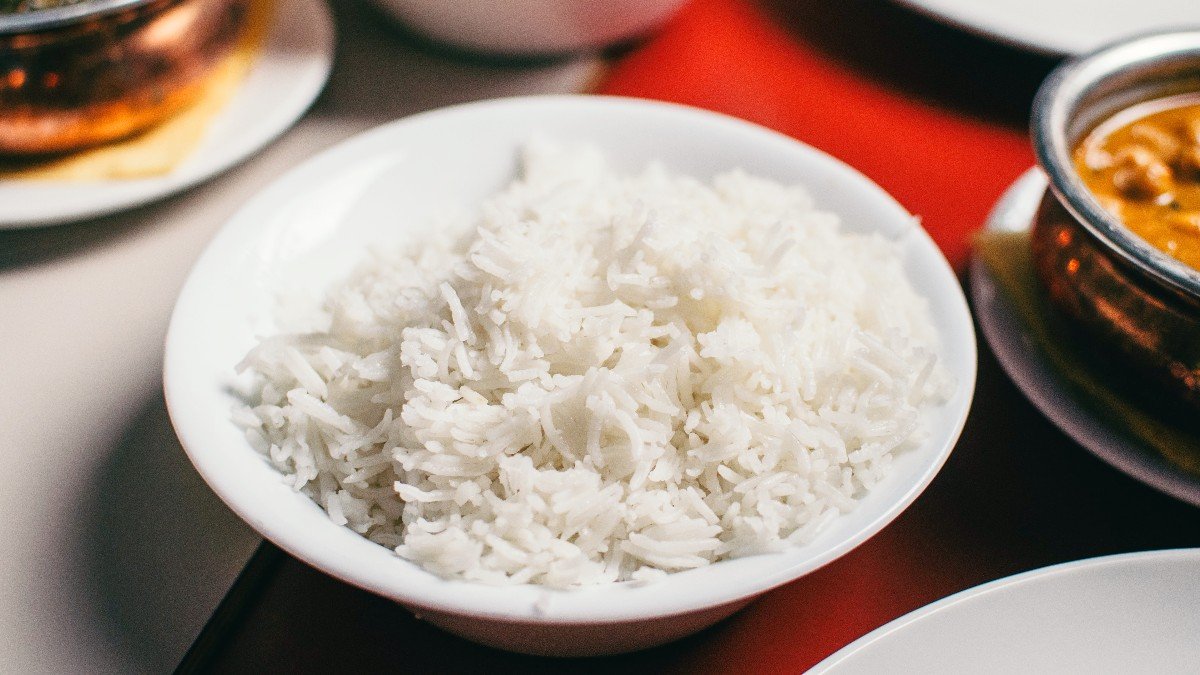Should We Eat Less Rice?

Rice is one of the most common foods in our pantries and cupboards. It’s a grain food we can rely on and is used across the world.
Rice is a natural staple food, so you’d think it must be sustainable, right?
Rice actually has a massive impact on the environment because of how much is cultivated annually and transported globally.
The answer isn’t to eat less rice though!
Despite releasing methane and nitrous oxide into the atmosphere, rice is a staple food for a reason, and ditching it for an alternative could have drastic consequences.
In China, abandoned rice fields converted into aquaculture to farm fish have been shown to release even more methane than rice had.
Is rice sustainable?
As with most edible plants, the conditions rice is grown heavily affect whether rice is sustainable or not.
Rice is native to Asia, where it’s largely cultivated in flooded fields to naturally reduce pests and weeds.
However, rice is responsible for around 30% of global agricultural methane emissions, as well as 11% of nitrogen emissions.
This doesn’t seem like a lot when you consider that 73.2% of global greenhouse gas emissions come from energy consumption, with just 18.4% of greenhouse gas emissions attributed to agriculture, forestry, and land use.
Until you read on and see that rice cultivation is its own sub-section and accounts for 1.3% of global greenhouse gas emissions.
The only reason this isn’t more of a worrying number is that rice is a staple food across the globe, providing around a fifth of the world’s calorie supply.
So why is rice seemingly so unsustainable?
Water usage in rice cultivation is a large part of it. Almost a third of the global supply of freshwater is used by rice farmers.
By growing rice in water-logged rice fields, an anaerobic environment is created, where organic matter degrades into carbon dioxide, methane, hydrogen sulfide, and energy.
This is why aerobic composting is seen as better than anaerobic composting – to limit how much methane is produced and released into the atmosphere.
Rice is also often exported, with the main exporters including Vietnam, Thailand, Pakistan, the United States, and India.
Compared to other carbohydrates, rice has a big impact on the environment. Basmati rice produces over three times as much greenhouse gas emissions as British potatoes at 0.17kg CO2e emissions.
Which rice is the most sustainable?
There are many different varieties of rice, whether you prefer white rice or brown rice. This makes it difficult to know which is the most sustainable, and transportation emissions mean it’s even harder – locally grown rice is more sustainable, but for many countries, there aren’t any local varieties.
Brown rice is whole grain rice that retains the bran layer and cereal germ layer, as opposed to white rice.
Whole grain rice is more nutritious as it contains more fiber, antioxidants, and vitamins and minerals. Because whole grain rice retains the bran and cereal germ layers, it goes through less processing than white rice, making it more eco-friendly.
White rice is generally divided between regular white rice and white basmati rice. Basmati rice contains more calories and carbs than regular white rice, and is primarily grown in India.
When choosing between whole grain and white rice, whole grain rice is the better option for both sustainability and health.
Basmati rice, whether whole grain or white, is more sustainable than regular brown rice or white rice.
Due to its low water footprint, low carbon footprint, and low environmental destruction, basmati rice is a sustainable rice variety.
While there are concerns about labor concerns, buying Fairtrade or similarly certified basmati rice ensures that laborers are being treated as fairly as possible.
Is organic rice better for the environment?
Organic rice of any variety is better for the environment because synthetic chemicals aren’t used during production.
Rice isn’t generally harmful to the environment or ecosystems unless deforestation or pesticides are used.
Buying certified organic or sustainable rice ensures that no synthetic pesticides or fertilizers were used to grow the rice.
Should we stop eating rice?
If everybody stopped eating rice and swapped to eating more pasta, would it be more sustainable?
The answer is a resounding no – despite how water-intensive rice cultivation is, it would be too difficult and expensive to repurpose rice fields to grow other crops that we think might be more eco-friendly.
Rice has been cultivated for over 8,000 years and resulted in over 40,000 varieties. It’s just not possible to stop everybody from eating rice.
Converting rice fields to aquaculture has already been shown to release even more methane into the atmosphere. This is most likely due to the converted aquaculture introducing more organic matter that degrades into methane and nitrous oxide, while previously rice cultivation had more of a balance.
The best we can do is to limit how much uncertified rice we eat.
By buying certified organic, sustainable, or fairtrade rice, we can limit the impact of rice on both the environment and those who rely on it for food security and income.
It’s better to buy products with ethical consumption in mind than it is to replace them without considering the effects of that alternative.
What rice does to the environment
Methane is the biggest problem associated with rice, as methane has such a large impact on both the environment and the ozone layer.
Methane is 80 times as impactful to global warming than carbon dioxide in just the first two decades of reaching the atmosphere.
When methane is produced, it helps form ground-level ozone – this is also known as tropospheric ozone which is especially concerning due to the health effects it causes. The troposphere is the lowest level of the planet’s atmosphere, which reaches from the ground to the highest levels of clouds.
90% of ozone exists in the stratosphere, with the remaining 10% in the troposphere.
Tropospheric ozone isn’t as damaging to the environment, though it is toxic to many plants and can reduce the yields of crops like soy, wheat, maize, and even rice itself. Rice is already known to be sensitive to temperature increases.
Lower rice yields will result in more land being cleared to create rice fields to meet demand, which can further the environmental impact of the crop.
Methane isn’t the only greenhouse gas released by rice fields either, as nitrous oxide is also produced in flooded fields.
Worse, intermittent flooding used to reduce methane emissions produces between 30 to 45 times more nitrous oxide than continuously flooded fields. This demonstrates how difficult it is to manage rice fields to be as sustainable as possible.
In the long-term, methane emissions aren’t as harmful as nitrous oxide, which stays in the atmosphere for around 100 years and has a global warming potential of up to 300 times that of carbon dioxide.
How sustainable is rice farming?
While it’s always worth remembering that rice provides a great deal of nutrition to billions of people globally, we also need to look at how sustainable farming practices are.
The amount of water required to grow rice is often beyond the amount the environment can naturally provide.
Many rice farms use a continual flow of water to ensure that the rice fields maintain a consistent height and avoid the build-up of salt.
Managing a balance between high rice yields and low water consumption is difficult, with the main options being to use rice crops that grow during shorter periods or planting later in the season. This is more likely to work in countries like the United States, but in other countries, many rice farmers rely on year-round yields not only for selling but also for their own survival.
Changes can be made to irrigation systems in rice fields, but changing an already maintained rice farm to accommodate this is expensive.
Efforts are being made to make rice farming more eco-friendly.
Research into making rice more sustainable is trying to find a trade-off between being environmentally friendly and producing enough rice to feed everyone who depends on rice.
In Arizona, one suggested method is using solar-powered drip irrigation technology to provide the roots of the crops with water instead of flooding fields. However, the benefits of flooding are to prevent pests and weeds, so changing this leads to another question: how to handle prevention and maintenance without relying on synthetic chemicals?
Paddy fields in southern China are thought to be the most sustainable option, where the flooded rice fields provide for fish and have their own ecosystems.
The fish eat pests and create a natural nutrient cycle. The fish are also sold, giving farmers an extra means of income and creating more food security.
Fish are also thought to reduce methane emissions in the rice paddy fields, and ducks might also be a valuable, eco-friendly alternative!
